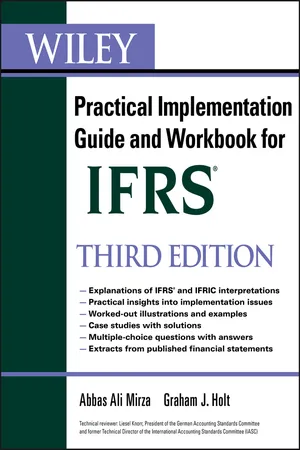
Wiley IFRS
Practical Implementation Guide and Workbook
- English
- ePUB (mobile friendly)
- Available on iOS & Android
About this book
A one-stop resource for understanding and applying current International Financial Reporting Standards
As the International Accounting Standards Board (IASB) makes rapid progress towards widespread acceptance and use of IFRS ® (formerly named International Accounting Standards) worldwide, the need to understand these new standards increases. Now fully revised and updated, IFRS ® Practical Implementation Guide and Workbook, Third Edition is the straightforward handbook for understanding and adapting the IFRS ® standards.
This quick reference guide includes easy-to-understand IAS/IFRS ® outlines, explanations, and practical insights that greatly facilitate understanding of the practical implementation issues involved in applying these complex standards.
Clearly explaining the IASB standards so that even first-time adopters of IFRS ® will understand the complicated requirements, the Third Edition presents:
- Ten recently issued and revised IFRS ® standards including business combinations, financial instruments and newly issued IFRS ® for SMEs
- New International Financial Reporting Interpretations Committee (IFRIC) projects
- Multiple-choice questions with solutions and explanations to ensure thorough understanding of the complex IFRS ® /IAS standards
- Case studies or "problems" with solutions illustrating the practical application of IFRS ® /IAS
- Excerpts from published financial statements around the world
Designed with the needs of the user in mind, IFRS ® Practical Implementation Guide and Workbook, Third Edition is an essential desktop reference for accountants and finance professionals, as well as a thorough review guide for the IFRS ® /IAS certification exam.
Frequently asked questions
- Essential is ideal for learners and professionals who enjoy exploring a wide range of subjects. Access the Essential Library with 800,000+ trusted titles and best-sellers across business, personal growth, and the humanities. Includes unlimited reading time and Standard Read Aloud voice.
- Complete: Perfect for advanced learners and researchers needing full, unrestricted access. Unlock 1.4M+ books across hundreds of subjects, including academic and specialized titles. The Complete Plan also includes advanced features like Premium Read Aloud and Research Assistant.
Please note we cannot support devices running on iOS 13 and Android 7 or earlier. Learn more about using the app.
Information
Chapter 1
INTRODUCTION TO INTERNATIONAL FINANCIAL REPORTING STANDARDS
INTRODUCTION
Need for a Common Set of Accounting and Financial Reporting Standards
What Are IFRS?
WORLDWIDE ADOPTION OF IFRS
Table of contents
- Cover
- Content
- Title Page
- Copyright
- Forewords to First Edition
- Preface
- Acknowledgements
- About the Authors
- 1. Introduction to International Financial Reporting Standards
- 2. IASB Framework
- 3. Presentation of Financial Statements (IAS 1)
- 4. Inventories (IAS 2)
- 5. Statement of Cash Flows (IAS 7)
- 6. Accounting Policies, Changes in Accounting Estimates and Errors (IAS 8)
- 7. Events After the Reporting Period (IAS 10)
- 8. Construction Contracts (IAS 11)
- 9. Income Taxes (IAS 12)
- 10. Property, Plant, and Equipment (IAS 16)
- 11. Leases (IAS 17)
- 12. Revenue (IAS 18)
- 13. Employee Benefits (IAS 19)
- 14. Accounting for Government Grants and Disclosure of Government Assistance (IAS 20)
- 15. The Effects of Changes in Foreign Exchange Rates (IAS 21)
- 16. Borrowing Costs (IAS 23)
- 17. Related-Party Disclosures (IAS 24)
- 18. Accounting and Reporting by Retirement Benefit Plans (IAS 26)
- 19. Consolidated and Separate Financial Statements (IAS 27)
- 20. Investments in Associates (IAS 28)
- 21. Financial Reporting in Hyperinflationary Economies (IAS 29)
- 22. Interests in Joint Ventures (IAS 31)
- 23. Financial Instruments: Presentation (IAS 32)
- 24. Financial Instruments: Recognition and Measurement (IAS 39)
- 25. Earnings Per Share (IAS 33)
- 26. Interim Financial Reporting (IAS 34)
- 27. Impairment of Assets (IAS 36)
- 28. Provisions, Contingent Liabilities, and Contingent Assets (IAS 37)
- 29. Intangible Assets (IAS 38)
- 30. Investment Property (IAS 40)
- 31. Agriculture (IAS 41)
- 32. First-Time Adoption of International Financial Reporting Standards (IFRS 1)
- 33. Share-Based Payments (IFRS 2)
- 34. Business Combinations (IFRS 3)
- 35. Insurance Contracts (IFRS 4)
- 36. Noncurrent Assets Held for Sale and Discontinued Operations (IFRS 5)
- 37. Exploration for and Evaluation of Mineral Resources (IFRS 6)
- 38. Financial Instruments: Disclosures (IFRS 7)
- 39. Operating Segments (IFRS 8)
- 40. Financial Instruments (IFRS 9)
- 41. IFRS for SMEs
- Answers for Multiple-Choice Questions
- Index
- End User License Agreement